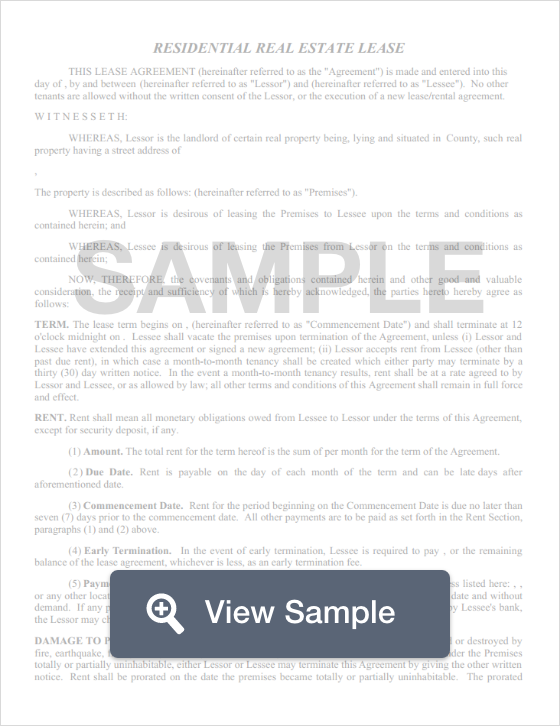When Should Someone Use a Lease?
Parties should use a lease any time they are entering into an agreement to rent a residential property. This includes landlords, tenants, and property managers. It's important for all parties involved to understand and outline the terms and conditions of a residential lease agreement prior to agreeing to the lease.
A valid agreement ensures that both sides are legally protected.
Lease Agreements can also be called:
-
Rental Lease
-
Rental Agreement
-
Apartment Lease
-
Rental Lease Agreement
-
Lease Form
-
Residential Lease Agreement
What Clauses Are Included in a Lease?
FormSwift’s comprehensive lease agreements include the following sections.
-
Property Details - This section denotes all major information about the property in question. This includes address, general description, as well as a legal description (sketch or survey)
-
Landlord Information - This section includes contact information for the landlord or Lessor. Typically, this contains at least a full name, address, and phone number.
-
Tenant Information - This section provides the names of all tenants. On a standard lease agreement, a maximum of three tenants may be listed but may vary depending on the property.
-
Terms of Residential Lease - This section includes the amount of rent due each period, the beginning and ending dates of the lease, the date the lease is signed, and the address to which lease payments must be sent. It also covers policies such as rent due date, late rent payment, and returned check penalties and security deposit information.
-
Rights Responsibilities & Liabilities of the Landlord - this section typically covers issues such as tax, repairs/maintenance, utilities, insurance, liability, and provision of furnishings.
-
Rights, Responsibilities & Liabilities of the Tenant - This section covers rights such as pets, guests, and peace, as well as responsibilities such as repairs/maintenance and utilities.
-
Damages & Insurance - This section deals with damages to the property - who is liable for what, and any insurance requirements
-
Keys - This portion details the number of keys distributed and the consequences of a tenant being locked out or losing his or her key.
-
Termination of Lease - This covers all aspects of lease termination. These include when a lease can be terminated, and how much notice must be given. If you need to cancel your lease contract before the agreed-upon end date, we recommend the lease cancellation agreement.
-
Lease Renewal - This section details when and how the lease may be renewed. It specifies whether or not the lease will be automatically renewed, and how long in advance the landlord must provide renewal documents.
-
Property Condition - This covers the results of the property inspection. These include general condition, wear and tear, and details that affect living conditions. These include: whether the property was built before 1978; whether any lead-based paint has been found on site; whether the property has flooded in the last three years.
FormSwift’s comprehensive lease includes legally compliant e-signatures, so that both sides can complete the transaction and save a copy with a single click.
To rent property, such as commercial property, high-rise offices, or local small business dwellings, use our commercial lease agreement.
Should My Lease Have a Set End Date?
With a month-to-month rental agreement, there is no specific term. The terms of the month-to-month lease or rental agreement will usually stipulate that a certain number of days of written notice (for example, 20 or 30 days of written notice) be provided before the termination of the rental contract.
The other type of rental agreement is a fixed-term agreement. Rather than allowing either party to terminate the contract at any time, a fixed-term lease agreement legally binds both the landlord and the tenant to abide by the terms of the rental agreement for a specific amount of time. A one-year contract is quite common, but multi-year contracts are also possible.
For landlords, a fixed-term contract means that he or she cannot raise the rent during the time of the lease; for tenants, it means that they cannot simply vacate the property and stop paying rent unless the lessee agrees to terminate the contract.
How Do I Use a Lease Agreement to Rent Out a Room?
A lease agreement can specify that a room is being rented, as opposed to the entire property.
Often, a sublease agreement, when a renter rents out a portion of their residential property to another renter, may be the most appropriate form.
Another good form to use to enforce house roles is a roommate agreement. A roommate agreement is a contract between roommates itemizing the particular accommodations of the roommate relationship. The agreement could include how much each party must pay for each month's rent and common utilities.
Download a PDF or Word Template
Lease Agreement
Lease agreements define the terms and conditions in place between two parties. One party is the owner of the property that is being leased. The other party will take temporary possession of the property. A signed lease agreement is important particularly if a legal dispute occurs.
 Read More
Read More
Month to Month
If you're getting into the rental business, a month-to-month lease is a must. A month-to-month lease agreement is an agreement that indicates that the renter and landlord are contracted only on a month to month basis.
 Read More
Read More
Sub-Lease
A sublease agreement is an agreement between the original renter and a third party. The third party is going to use the property during the absense of the original renter. The sublease agreement lines out the terms and coniditons for this arrangement.
 Read More
Read More
Rental Application
A rental application is an important screening tool for landlords. This application requests specific information about the potential tenant, such as former rental history and job history. This information is vital for landlords because it helps them determine if the potential tenant should be allowed to rent the property.
 Read More
Read More

